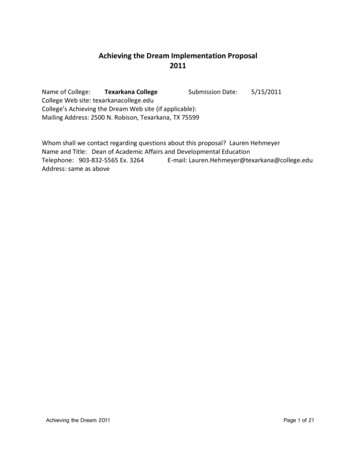
Transcription
Achieving the Dream Implementation Proposal2011Name of College:Texarkana CollegeSubmission Date:College Web site: texarkanacollege.eduCollege’s Achieving the Dream Web site (if applicable):Mailing Address: 2500 N. Robison, Texarkana, TX 755995/15/2011Whom shall we contact regarding questions about this proposal? Lauren HehmeyerName and Title: Dean of Academic Affairs and Developmental EducationTelephone: 903-832-5565 Ex. 3264E-mail: Lauren.Hehmeyer@texarkana@college.eduAddress: same as aboveAchieving the Dream 2011Page 1 of 21
Achieving the Dream Implementation Proposal2011Quantitative Data Analyzed:In the Fall of 2010, all Texarkana College employees and a representative group ofstudents analyzed cohort data for the academic years 2007-08, 2008-09, and2009-10 to look for trends or significant indicators in developmental educationand gateway courses. Employees and students compared student subpopulations based on the characteristics of race/ethnicity, gender, age group,and Pell Grant status. Participants specifically focused on successful completionrates defined as completing a course with a grade of A, B, or C. One area ofanalysis that provoked considerable discussion as a barrier to student successand persistence was developmental and gateway mathematics courses. Inmathematics participants determined a need to improve these successfulcompletion rates, particularly in the middle level developmental course Math0032. Successful completion rates for the lowest and highest levels ofdevelopmental mathematics hover just below 50% while rates in the middlecourse of the sequence ranged from the mid-30% to mid-40% for the majority ofthe sub-populations. Indicators in the gateway math course College Algebra(Math 1314) showed somewhat better statistics with the majority of subpopulations ranging from the mid-50% to mid-60% for successful completion.Another source of quantitative data analysis at Texarkana College that has beenongoing involves our Quality Enhancement Plan (QEP). In 2006, TexarkanaCollege initiated a student success course as part of the QEP. Academicallyunderprepared students were targeted for participation in the course.Specifically, students placing into all three developmental education programs,reading, mathematics and English, were identified and required to take thestudent success course. Challenges in advising and proper placement resulted ina portion of that target population failing to enroll in the course, hencebecoming an accidental control group for comparison. Over the past five years,TC tracked GPA, persistence, and successful course completion rates for thetreated population (those students in all three developmental educationprograms and enrolled in the success course), the non-treated population (thosestudents in all three developmental education programs but not enrolled in thesuccess course), and all FTIC students. These data served as a basis forexamining and comparing persistence and successful course completion rates forFTIC students as well as the most academically underprepared students. Theresulting data analysis provoked a discussion regarding the barriers to studentsuccess and persistence for all populations. Although general Fall to Fallpersistence at Texarkana College is higher than some community colleges, it wasAchieving the Dream 2011Page 2 of 21
still disheartening for the underprepared and general population of students.Discussions led to the conclusion that some changes needed to be made inclasses that would encourage persistence across the board (based upon thegeneral persistence shown by schools that have implemented active andcollaborative learning) and would build upon what has been learned from thecurrent trial of student success classes, which were part of the QEP initiative thattargets underprepared students.For example, the QEP data gave telling statistics about the underpreparedpopulation. The five-year average for Fall to Spring persistence rates for eachcohort is as follows: FTIC 73%, treated 64%, and non-treated 57%. The five yearaverage for Fall to Fall persistence rates for each cohort shows a drop for allgroups (FTIC 48%, treated 35%, and non-treated 38%).Analysis of successful course completion (defined as receiving a grade of A, B, orC) merits a discussion of a few local factors that may have influenced results.Baseline data from 2006 showed both treated and non-treated cohorts achievingbasically the same successful completion rate of approximately 70% in collegecredit courses while the FTIC cohort was 84%. In 2007 the treated cohortshowed improvement moving to a successful completion rate of 79%, with FTIC83%, and the non-treated cohort dropping to 66%. However, in 2008-2009 TCexperienced a dramatic administrative transition, and the QEP lost a degree ofinstitutional focus during this transition. During these years, the treatedpopulations dropped in performance showing similar successful completion ratesto their non-treated counterparts (70-72%) while FTIC students remainedconsistent at 82%. With the administrative transition complete and the QEPgiven new leadership, the 2010 results show promise. The treated cohortachieved a successful college credit course completion rate of 84%, while FTICwas 80%, and the non-treated cohort dropped to 65%.The trends for successful completion rates in developmental education (DE)courses were different. While the treated populations in DE courses showedpersistence rates approximately 10-20% higher than the FTIC and non-treatedcohorts, their successful completion rates were approximately 10% lower. Thissomewhat inverse relationship in performance between persistence andsuccessful completion in developmental courses can be attributed to what was astate mandate that withdrawal from a DE course would result in the studentbeing dropped from college enrollment. Students in the treated cohortsunderstood this policy more completely; therefore, they did not withdraw from acourse even if they were failing. The non-treated and FTIC populations showedhigher withdrawal rates with an implication that the majority of these studentsonly persisted in a course if they were passing. As a result, the treated cohortAchieving the Dream 2011Page 3 of 21
data included more students persisting in spite of certain failure leading to lowersuccessful completion rates in the DE coursework.Analysis of Fall GPA results for each cohort over time shows FTIC studentsremaining constant around 2.5, while treated students hold an average of 2.1(with a notable exception in 2010 where the GPA was 2.5) and non-treatedstudents hold an average of 1.7. This is an indication that the success coursedoes provide significant momentum to academically underprepared students tomove closer in performance to their academically prepared peers.Analysis of all cohorts over time for their second semester of enrollment eachspring leads to some perplexing results. In general, persistence rates remainsimilar for all cohorts as in the Fall semesters. However, successful completionrates and GPAs show a significant decline for the treated populations while theFTIC and non-treated populations remain comparable to their Fall performance.Upon analysis of the ratio of coursework dedicated to DE versus college credit,there is an increase in the number of college credit courses taken by all students,treated or not, in the spring semester which may be part of the explanation forthe drop in GPAs and successful completion rates. The more rigorous coursework in college credit courses may explain the decline for the fSpringRatioofQualitative Data Analyzed:After presenting the findings of the cohort data, potential reasons for the various trends orAchieving the Dream 2011Page 4 of 21
significant indicators emerged in the data. After several weeks, attendees (again all employeesand a representative group of students) reconvened to discuss and identify these potentialreasons. Attendees were divided into small discussion groups of 8 or fewer which included ateam facilitator/reporter for each group as the groups worked through each set of findings inthe data by category such as developmental education, gateway courses, etc. to makerecommendations. Each discussion group reported back to the collective group both verballyto generate a collective dialogue and consensus and in writing to document the results. In thearea of developmental and gateway mathematics, four major factors emerged: institutionalresponsibility, preparedness, educational prerequisites, and race/gender.In addition to this formal attempt to analyze the data qualitatively, attendees wanted to gain amore personal understanding as to what factors reduce student success and persistence withinthe student population. Texarkana College employs a full-time Retention Coordinator whoroutinely performs phone and face-to-face interviews with a target population of students thatis considered underprepared. This population coincides with both the treated and non-treatedpopulations from our QEP. Using the criteria above for the 2011 Fall semester, over 200students were indicated as underprepared and were interviewed by phone and/or face-to-faceto establish student perception of barriers to success and persistence. Based on thoseinterviews, over 60% responded that math concerns were the major inhibitor to their success.The Retention Coordinator found that a consistent portion of those students interviewed alsohad major issues in time management, study skills, and critical thinking skills. Further, thesequalitative data support the development of three AtD interventions at TC: 1) Developmentaland Gateway Mathematics, 2) Student Success Courses, and 3) Active and CollaborativeLearning to Improve Student Success and Critical Thinking.Major Findings of Data Analysis:In the area of mathematics, developmental and gateway successful completionrates need improvement. For many students, persistence and success in collegehinges upon the critical area of mathematics. Upon analysis of employeeperceptions, Texarkana College can improve the successful completion rates ofstudents in developmental and gateway mathematics courses by streamliningthe process for meeting these mathematical prerequisites for degree seekingstudents and designing course curricula that facilitate student preparedness. Inaddition, best practices at other AtD colleges (featured at the 2011 AtD StrategyInstitute) show that streamlined mathematics curriculum, such as“collaborative” modular math and integrated intermediate and College Algebra,encourages completion of the developmental mathematics sequence. Thewebinar “IPads: The Latest and Greatest in Educational Tools?” by InstructionalTechnology Council and Elluminate 2011 (Presenters: Sue Buchholz, AssociateProfessor, Wakita Rucker Bradford, Wakita Rucker Bradford, RN, MSN, CPN,Nursing Community Outreach and Educational Technology Coordinator, GeorgiaPerimeter College) supports the collaborative modular mathematics concept.The research by the Community College of Baltimore County (CCBC) entitledAchieving the Dream 2011Page 5 of 21
“Accelerated Learning Project” supports the concept of integrated intermediateand College Algebra. Both of these concepts shorten the sequence ofdevelopmental mathematics by not only accelerating, but doing the mathdifferently (Walter S. Johnson Foundation “Acceleration in Context.”The evidence also shows that improvement is needed in successful course completion rates andlong-term persistence for all populations, but more specifically, academically underpreparedpopulations. In addition, the qualitative data specifically indicate a major gap in students’ability to perform many of the most critical functions in the areas of time management, studyskills, and critical thinking. To improve student success, much work needs to be done throughthe Texarkana College Student Success Initiative and the implementation of active andcollaborative learning in courses across the curriculum.Collaborative learning styles of teaching have shown a clear correlation to persistence andlearning according to Chickering and Gamson, and Kuh. Karp and Hughes have recently addedto the research, arguing that an active classroom particularly increases engagement incommunity colleges. Arum and Roksa in their acclaimed Academically Adrift confirm thatcollaborative learning increases student learning but caution that faculty must be properlytrained in order to make sure that faculty create “specifically structured contexts that focusstudents’ attention appropriately on learning “(133). Patrick Henry Community College hasreported great success with this type of initiative.In addition to research that supports the use of active and collaborative learning to ensurestudent success, Texarkana College has a unique and local reason to launch this initiative. Thelargest local school district, Texarkana Independent School District (TISD) has trained a majorityof its teachers to follow the “engineering project management” model. This model is currentlyused in the lower grades, and it is being moved upward. In a few short years, the studentsentering TC’s doors will be familiar with more active learning styles. TC must be ready for them.Helpfully, a small group of TC faculty has considerable expertise in active and collaborativelearning strategies; drawing on their expertise and the expertise of outside trainers, this base oftrained individuals can be expanded to include more faculty.The emergence of these three priorities exhibits a commitment to serve all populations throughefforts to streamline the mathematics program through the implementation of active andcollaborative learning across the classroom culture and through the improvement andexpansion of student success courses.Stakeholders Engaged in Priority-Setting:Texarkana College has included employees at all levels both full-time and part-time, staff,faculty, administrators, and student representatives in the analysis of data and development ofrecommendations. In addition, the President has regularly informed the Board of Trustees ofprogress on proposed initiatives.Other Information Regarding the Decision Making Process:As the proposed math intervention emerged as a potential focal point for the TC AtD initiative,Achieving the Dream 2011Page 6 of 21
all full-time mathematics faculty met to consider the data presented in greater depth todevelop a proposal for implementing more effective strategies within the developmental andgateway mathematics courses to improve successful completion rates of students within themath program. The Core and Data Teams met regularly, exchanging information andconversing about ways for the college to use that information to create a better success rate forstudents.Through the analysis of existing data from the QEP, coupled with the research of best practicesof other community colleges, it was decided that the current student success course could bemodified and improved to increase successful completion rates and persistence of students.Similarly, those same indicators should be improved by impacting the classroom culture of TCas a whole through the implementation of professional development for active andcollaborative strategies for the classroom.Resulting Priority:Several priorities emerged involving reducing barriers to student success and persistencethrough 1) increasing developmental and gateway mathematics completion, 2) improving andexpanding student success courses, including the redesign of a mentoring program, and 3)implementing collaborative and active learning to improve critical thinking.Intervention Name:Intervention #1 A) Modular Developmental Math B) Integrated Intermediate and CollegeAlgebra C) Math Boot CampIntervention #2 (A) College Success Strategies (B) Mentoring RedesignIntervention #3. Collaborative and Active Learning in the ClassroomDirect or Indirect Student Intervention:Direct / IndirectIntervention #1 DirectIntervention #2. Direct (1) Students will directly be impacted by their enrollment andparticipation in the student success course. Prior to full scale-up, this intervention will bemeasured by using the treated group of enrolled students. The success of these students willbe analyzed after course completion and will be compared to those students not enrolled in thecourse. If analysis indicates that this is a successful intervention, then scale-up will result in allstudents being enrolled; thus, measurement will be done through comparison with earlierestablished baseline data.(2) Students enrolled in the student success course will have an assigned advisor to workdirectly with them to provide resources and interventions as needed during the first semesterenrolled at Texarkana College. Perceptions of these students will be compared to the generalstudent population.Intervention #3. Direct This intervention will be measured by analyzing the performance(completion with A,B,C) and retention (persistence Fall to Fall) data of students in thecollaborative learning classes.Indirect: Faculty perceptions will also be measured.Start Date:Achieving the Dream 2011Page 7 of 21
Intervention #1A) Spring 2012 B) Spring 2012 C) Fall 2012Intervention #2. (1) The student success course continues to be taught at Texarkana College,and in the Fall of 2011, a systemic data comparison will be conducted for each semester toaddress the achievement gaps of students enrolled in the course compared to their FTICcounterparts. Hiring of a full-time faculty member to deliver the methodology of studentsuccess courses is imperative for students to receive the full benefits of a student successcourse. Training for all faculty members on the implementation of college success strategiesacross the curriculum will be conducted in the Summer 2012 and be on-going throughout thecoming years. (2) The hiring of a full-time advisor to manage students enrolled in the studentsuccess course will begin after examining the effects the class has on students in the Fall of2011 and the Spring of 2012, determining which strategies need to be implemented by theadvisor. The advisor will begin work with these students in the Fall of 2013.Intervention #3. Fall 2011. One awareness activity took place in Fall 2010. Ten full-time facultytoured and observed a local school system that uses collaborative learning techniques.Type of Intervention (choose all applicable):Intervention #1 Advising, Developmental Education, Equity, Faculty Professional Development,Gatekeeper Courses, Improved Use of Data, Institutional Effectiveness, Institutional Research, K14 Strategies (through coordination with local public schools to identify students in need ofMath Boot Camp), Program Evaluation Process, Supplemental Instruction (not formal nationalprogram but rather an additional supporting form of instruction external to class time),TutoringIntervention #2. Advising, Developmental Education, Equity,Faculty Professional Development, First-Year Experience, Gatekeeper Courses, Improved Use ofData, Information Systems, Institutional Effectiveness,Institutional Research, Internal Policy Review & Update,Learning Communities, Other (Direct), Other (Indirect), Program Evaluation Process, Studentsuccess course, Student Support Services, Supplemental Instruction, TutoringIntervention #3 Developmental Education, Equity, Faculty Professional Development, First YearExperience, Gatekeeper Courses, Institutional Effectiveness, Institutional Research, ProgramEvaluation Process*Specific Course Content Area (choose all applicable):Math / English / ReadingIntervention #1 MathIntervention #2. Math / English / ReadingStudents who are enrolled in three developmental areas must enroll in the student successcourse. Scale up will include all students needing two developmental courses after the thirdyear and in the fourth year all students who are enrolled in one
the process for meeting these mathematical prerequisites for degree seeking . Nursing Community Outreach and Educational Technology Coordinator, Georgia . (CCBC) entitled . Achieving the Dream 2011 Page 6 of 21 “Accelerated Learning











